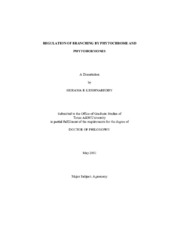| dc.description.abstract | Light is the fundamental source of energy and information throughout the plant life cycle. Light signals regulate plant architecture and branching, key processes that determine biomass production and grain yield. Low red (R) to far-red (FR) light ratios (R:FR) perceived by phytochromes serve as a warning signal about impending competition for light resources and lead to shade avoidance responses (SARs), including reduced branching. The R:FR regulates branching in both a bud autonomous and non-bud autonomous manner, however a detailed mechanistic understanding of the process remains unclear. We hypothesized that high R:FR promotes bud outgrowth by differentially regulating branching-related genes (transcriptome) within the axillary bud and that increased apical dominance under low R:FR or with phyB deficiency is mediated by auxin or other novel signal/s. We analyzed the branching phenotype of Arabidopsis Columbia-60000 ecotype in response to different R:FR treatments and conducted a microarray study to identify early (within 3 hours) changes in the transcriptome of buds from different rosette positions in response to altered R:FR. Physiological experiments were also conducted to determine if auxin concentration, transport rate, sensitivity, and establishment of an auxin transport stream were important in determining the branching phenotype of shade avoiding plants.
The results revealed that the duration of low R:FR determines plant architecture and the branching phenotype and that bud outgrowth is regulated by the R:FR in a spatial and temporal manner. Low R:FR promoted the elongation of branches at top rosette nodes while it suppressed the outgrowth of axillary buds at lower nodes. High R:FR could reverse the effects of previous low R:FR by promoting the outgrowth of buds from lower axils within 24 hours of treatment. Transcriptomic analysis revealed that the R:FR differentially regulated the expression of genes related to hormone biosynthesis/transport/signaling, cell-cycle regulation and cell wall modification. Cis-elements responsive to light and hormone signaling pathways were overrepresented in several gene clusters. Apical dominance related studies discovered that loss of phyB function results in a slower auxin transport rate, fewer xylem parenchyma cells, and reduced sensitivity to auxin. These results, in addition to estimates of correlative inhibition, suggested that auxin is at least partially responsible for increased apical dominance under low R:FR or with phyB deficiency, but may be acting in conjunction with other undefined regulators. | en |


